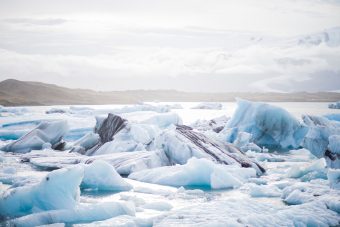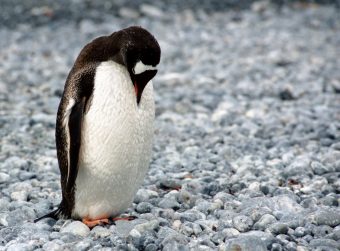
We’ve all seen haunting images of receding glaciers, but how many of us have ventured into their melting heartlands, felt the ancient ice slipping away or heard the roar as it cascaded into the ocean?
An immersive approach to the climate crisis not only sparks much-needed collective action among government, science and business, but can also lead to more environmentally conscious decisions in the physical world. By transporting decision-makers into hard-to-reach environments via virtual tools, it makes the abstract tangible. It makes the distant Arctic and Antarctic crises accessible, immediate and undeniable.
We need to make people appreciate the imminent threat
For years, science has sounded alarm bells about climate change, highlighting the vast ecological shifts taking place in our polar regions. Now, as world leaders gather for the UN General Assembly, we are teetering on the edge of critical thresholds that could send our world into irreversible damage.
Arctic summer sea ice, a sentinel of global climate health, is projected to reach one of the lowest levels in recorded history this year. Since 1979, sea ice cover at the end of summer has shrunk by a concerning 13 percent per decade.
This loss triggers a domino effect. The vanishing ice causes the Arctic Ocean surface waters to warm, amplifying the region’s warming. This increased warming in the Arctic influences the Greenland ice sheet melt and permafrost thaw, which would cause disruption of large-scale weather patterns, an increase in extreme weather events across the northern hemisphere and a change in the Arctic’s heat-reflecting abilities. The sheer magnitude of these intertwined systems sounds a warning: Our planet’s stability is hanging by a thread.
More:
- EXTREME WEATHER IS THE “NEW NORM”
- COP28 PRESIDENT-DESIGNATE CALLS FOR HOLISTIC ECOSYSTEM TO DRIVE CLIMATE ACTION DURING LONDON CLIMATE ACTION WEEK
- HOW INDIA’S CLIMATE LEADERSHIP IS BUILDING A BETTER FUTURE FOR ALL
Climate crisis: nearing the point of no return
Of 16 climate tipping points, critical thresholds where relatively small changes in conditions can lead to abrupt and often irreversible shifts in the climate system, five lie in the polar regions. And here’s the rub: At just +1.5°C of warming, the target of the Paris Agreement, three of these – Greenland Ice Sheet collapse, West Antarctic Ice Sheet collapse and Boreal Permafrost abrupt thaw – will be triggered. What makes this particularly concerning is that as these tipping points are activated, they can exacerbate global warming themselves, creating a self-reinforcing cycle. This, in turn, could propel our world into a state that’s more than +2°C warmer, with dire consequences for ecosystems and societies worldwide.
It’s clear that we’re facing a climate emergency. But when talking about melting ice at our planet’s poles, it can be hard to visualize what that means for the world, for its people and for us each individually. Leading voices on global environmental risks have long remarked on the need for greater awareness surrounding critical ecological challenges and their potential consequences. It can be even harder to translate that urgency into the many steps – both large and small – that will help us collectively come together to address it.
All is not lost

The good news is that even as the crisis grows, so does our capacity to address it. Emerging technologies, including artificial intelligence (AI), virtual reality (VR) and augmented reality (AR), serve as powerful tools that help us realize the challenges we face – while also powering platforms that can elevate diverse voices and advance ideas in our efforts to solve it.
In the World Economic Forum’s Global Collaboration Village, a purpose-driven platform powered by next-generation technology and initiated by the World Economic Forum in partnership with Accenture and Microsoft, a new Polar Tipping Points Hub has been unveiled. Developed with expertise from Arctic Basecamp, this hub offers a unique visualization of all the climate tipping points and the potential cascading risks they pose.
By pooling data from institutions, including Arctic Basecamp, NASA, and the National Snow and Ice Data Centre (NSIDC), the hub employs live simulations to present a unique visualization of impending threats, such as sea-level rise, extreme weather events, heat stress and heat waves, compromised food and water security, climate migration, disease exacerbation and disruptions in logistics and supply chains.
In the hub, people can harness immersive digital landscapes to conduct intricate real-time simulations and modelling of future situations, enabling them to examine polar warming trends that depict the consequences of not meeting climate targets, including the loss of sea ice, permafrost thaw and ice sheet collapses. This unique experience also showcases how one global risk is connected to the other, through polar change. It also highlights how triggering climate tipping points can drive temperatures higher than anticipated.
The world is at a crossroads. We must increase awareness of the crisis we face – and we must translate that awareness into tangible action. By leveraging the best of technology, we can pave the way for innovative, collaborative solutions and, in doing so, create a brighter, more sustainable future for all.
Source: World Economic Forum



